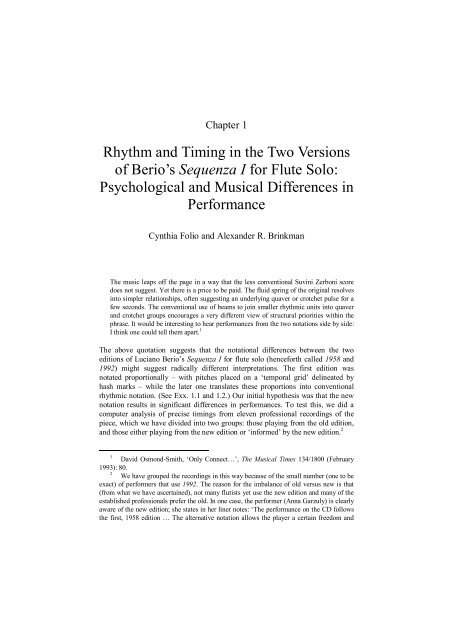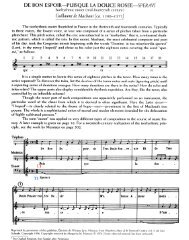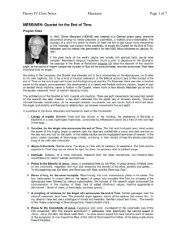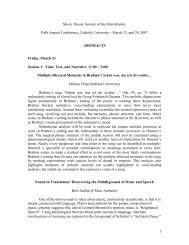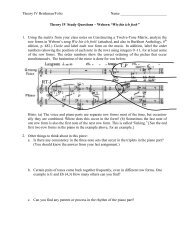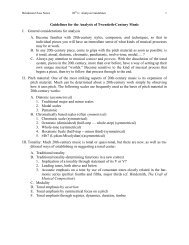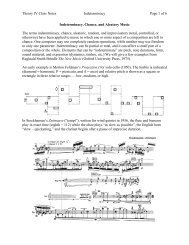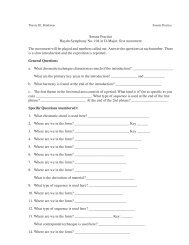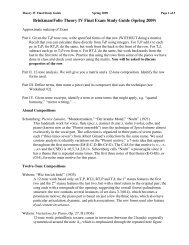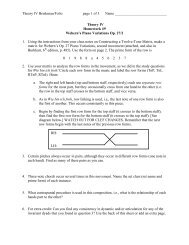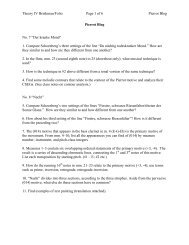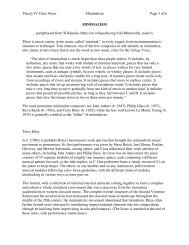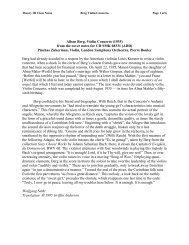Rhythm and Timing in the Two Versions of ... - Temple University
Rhythm and Timing in the Two Versions of ... - Temple University
Rhythm and Timing in the Two Versions of ... - Temple University
You also want an ePaper? Increase the reach of your titles
YUMPU automatically turns print PDFs into web optimized ePapers that Google loves.
Chapter 1<br />
<strong>Rhythm</strong> <strong>and</strong> <strong>Tim<strong>in</strong>g</strong> <strong>in</strong> <strong>the</strong> <strong>Two</strong> <strong>Versions</strong><br />
<strong>of</strong> Berio’s Sequenza I for Flute Solo:<br />
Psychological <strong>and</strong> Musical Differences <strong>in</strong><br />
Performance<br />
Cynthia Folio <strong>and</strong> Alex<strong>and</strong>er R. Br<strong>in</strong>kman<br />
The music leaps <strong>of</strong>f <strong>the</strong> page <strong>in</strong> a way that <strong>the</strong> less conventional Suv<strong>in</strong>i Zerboni score<br />
does not suggest. Yet <strong>the</strong>re is a price to be paid. The fluid spr<strong>in</strong>g <strong>of</strong> <strong>the</strong> orig<strong>in</strong>al resolves<br />
<strong>in</strong>to simpler relationships, <strong>of</strong>ten suggest<strong>in</strong>g an underly<strong>in</strong>g quaver or crotchet pulse for a<br />
few seconds. The conventional use <strong>of</strong> beams to jo<strong>in</strong> smaller rhythmic units <strong>in</strong>to quaver<br />
<strong>and</strong> crotchet groups encourages a very different view <strong>of</strong> structural priorities with<strong>in</strong> <strong>the</strong><br />
phrase. It would be <strong>in</strong>terest<strong>in</strong>g to hear performances from <strong>the</strong> two notations side by side:<br />
I th<strong>in</strong>k one could tell <strong>the</strong>m apart. 1<br />
The above quotation suggests that <strong>the</strong> notational differences between <strong>the</strong> two<br />
editions <strong>of</strong> Luciano Berio’s Sequenza I for flute solo (henceforth called 1958 <strong>and</strong><br />
1992) might suggest radically different <strong>in</strong>terpretations. The first edition was<br />
notated proportionally – with pitches placed on a ‘temporal grid’ del<strong>in</strong>eated by<br />
hash marks – while <strong>the</strong> later one translates <strong>the</strong>se proportions <strong>in</strong>to conventional<br />
rhythmic notation. (See Exx. 1.1 <strong>and</strong> 1.2.) Our <strong>in</strong>itial hypo<strong>the</strong>sis was that <strong>the</strong> new<br />
notation results <strong>in</strong> significant differences <strong>in</strong> performances. To test this, we did a<br />
computer analysis <strong>of</strong> precise tim<strong>in</strong>gs from eleven pr<strong>of</strong>essional record<strong>in</strong>gs <strong>of</strong> <strong>the</strong><br />
piece, which we have divided <strong>in</strong>to two groups: those play<strong>in</strong>g from <strong>the</strong> old edition,<br />
<strong>and</strong> those ei<strong>the</strong>r play<strong>in</strong>g from <strong>the</strong> new edition or ‘<strong>in</strong>formed’ by <strong>the</strong> new edition. 2<br />
1<br />
David OsmondSmith, ‘Only Connect…’, The Musical Times 134/1800 (February<br />
1993): 80.<br />
2<br />
We have grouped <strong>the</strong> record<strong>in</strong>gs <strong>in</strong> this way because <strong>of</strong> <strong>the</strong> small number (one to be<br />
exact) <strong>of</strong> performers that use 1992. The reason for <strong>the</strong> imbalance <strong>of</strong> old versus new is that<br />
(from what we have ascerta<strong>in</strong>ed), not many flutists yet use <strong>the</strong> new edition <strong>and</strong> many <strong>of</strong> <strong>the</strong><br />
established pr<strong>of</strong>essionals prefer <strong>the</strong> old. In one case, <strong>the</strong> performer (Anna Garzuly) is clearly<br />
aware <strong>of</strong> <strong>the</strong> new edition; she states <strong>in</strong> her l<strong>in</strong>er notes: ‘The performance on <strong>the</strong> CD follows<br />
<strong>the</strong> first, 1958 edition … The alternative notation allows <strong>the</strong> player a certa<strong>in</strong> freedom <strong>and</strong>
2 Cynthia Folio <strong>and</strong> Alex<strong>and</strong>er R. Br<strong>in</strong>kman<br />
The discussion consists <strong>of</strong> four parts: (1) background, which <strong>in</strong>cludes a history<br />
<strong>of</strong> <strong>the</strong> notation <strong>of</strong> Sequenza I <strong>and</strong> a short summary <strong>of</strong> o<strong>the</strong>r writ<strong>in</strong>gs that compare<br />
old <strong>and</strong> new editions; (2) a discussion <strong>of</strong> <strong>the</strong> real <strong>and</strong> psychological differences <strong>in</strong><br />
play<strong>in</strong>g from <strong>the</strong> two different scores, supported by <strong>in</strong>terviews with pr<strong>of</strong>essional<br />
flutists; (3) a description <strong>of</strong> our method; <strong>and</strong> (4) results, <strong>in</strong>clud<strong>in</strong>g presentation <strong>of</strong><br />
<strong>the</strong> performance data <strong>and</strong> a summary <strong>of</strong> <strong>the</strong> rhythmic <strong>and</strong> <strong>in</strong>terpretive differences<br />
among performances.<br />
The primary aim <strong>of</strong> our study is to analyze pr<strong>of</strong>essional record<strong>in</strong>gs <strong>in</strong> order to<br />
provide <strong>in</strong>sights <strong>in</strong>to <strong>the</strong> performance tradition <strong>of</strong> Sequenza I <strong>and</strong> demystify <strong>the</strong><br />
real musical differences between <strong>the</strong> ‘free’ <strong>and</strong> ‘controlled’ notational systems <strong>of</strong><br />
<strong>the</strong> two editions.<br />
Background: <strong>the</strong> two versions <strong>of</strong> Sequenza I<br />
The history <strong>of</strong> Berio’s notational decisions for this piece is quite <strong>in</strong>terest<strong>in</strong>g, <strong>and</strong><br />
has been described by Benedict Weisser. 3 Evidently, Berio’s <strong>in</strong>itial <strong>in</strong>tention was<br />
to use precise, metered notation for 1958: ‘He orig<strong>in</strong>ally wrote it <strong>in</strong> exceptionally<br />
f<strong>in</strong>e detail (almost like Ferneyhough <strong>in</strong> <strong>the</strong> orig<strong>in</strong>al form), but Gazzelloni could not<br />
h<strong>and</strong>le it, so Berio decided to use proportional notation.’ 4 This suggests that <strong>the</strong><br />
proportional notation came about, at least <strong>in</strong> part, as a solution to a problem. Berio<br />
had this to say about <strong>the</strong> issue <strong>of</strong> notation <strong>in</strong> an <strong>in</strong>terview with Weisser:<br />
Usually, I’m not concerned with notation itself. When I’m concerned, that means <strong>the</strong>re’s<br />
a problem. The issue <strong>of</strong> notation comes out, at least <strong>in</strong> my own musical perspective,<br />
when <strong>the</strong>re is a dilemma, when <strong>the</strong>re is a problem to be solved. And that pushes me to<br />
f<strong>in</strong>d solutions that maybe I was never pushed to f<strong>in</strong>d before. 5<br />
Whe<strong>the</strong>r he <strong>in</strong>tended it or not, Berio’s notation <strong>of</strong> Sequenza I became <strong>the</strong> focus <strong>of</strong><br />
attention for both musicians <strong>and</strong> literary <strong>the</strong>orists who were proponents <strong>of</strong> <strong>the</strong><br />
flexibility <strong>in</strong> <strong>the</strong> frame <strong>of</strong> strictly notated discipl<strong>in</strong> [sic].’ Anna Garzuly, Flute Visions <strong>of</strong> <strong>the</strong><br />
20 th Century, Hungaroton Classic, 1996, l<strong>in</strong>er notes. When we say <strong>the</strong> flutist is ‘<strong>in</strong>formed’<br />
by <strong>the</strong> new edition, we mean that s/he has studied it <strong>and</strong> has <strong>in</strong>corporated some <strong>of</strong> <strong>the</strong><br />
<strong>in</strong>formation from 1992 while still read<strong>in</strong>g from 1958. When we did not have direct<br />
documentation (ei<strong>the</strong>r <strong>in</strong> <strong>the</strong> l<strong>in</strong>er notes or through correspondence with <strong>the</strong> performers), we<br />
determ<strong>in</strong>ed which edition was used from isolated <strong>in</strong>stances <strong>in</strong> which notes <strong>and</strong>/or register<br />
were changed <strong>in</strong> <strong>the</strong> new edition.<br />
3 Benedict Weisser, Notational Practice <strong>in</strong> Contemporary Music: A Critique <strong>of</strong> Three<br />
Compositional Models (Luciano Berio, John Cage <strong>and</strong> Brian Ferneyhough) (Ph.D.<br />
Dissertation, CUNY, 1998), pp. 37–76.<br />
4<br />
Ibid., p. 38. This quote is from a letter to Weisser from Nicholas Hopk<strong>in</strong>s (Berio’s<br />
former musical assistant); accord<strong>in</strong>g to Hopk<strong>in</strong>s, <strong>the</strong>se sketches now reside <strong>in</strong> <strong>the</strong> Paul<br />
Sacher Stiftung <strong>in</strong> Basel.<br />
5<br />
Ibid., p. 240.
Sequenza I for Flute 3<br />
opera aperta, or ‘<strong>the</strong> open work’. Umberto Eco lists <strong>the</strong> Sequenza alongside<br />
Karlhe<strong>in</strong>z Stockhausen’s Klavierstück XI (1956) <strong>and</strong> o<strong>the</strong>r works <strong>of</strong> <strong>the</strong> period that<br />
<strong>of</strong>fered a multiplicity <strong>of</strong> <strong>in</strong>terpretations, based on performers’ choices. 6 Thomas<br />
Gartmann considers this <strong>in</strong>clusion <strong>of</strong> Berio’s work <strong>in</strong> this list as a ‘wellknown<br />
misunderst<strong>and</strong><strong>in</strong>g’ [e<strong>in</strong> fruchtbares Missverständnis] <strong>of</strong> Berio’s <strong>in</strong>tent. 7 S<strong>in</strong>ce its<br />
premiere by Gazzelloni <strong>in</strong> 1958, Sequenza I has become one <strong>of</strong> <strong>the</strong> three most<br />
important twentiethcentury solo pieces <strong>in</strong> <strong>the</strong> flute repertoire – <strong>the</strong> o<strong>the</strong>rs be<strong>in</strong>g<br />
Debussy’s Syr<strong>in</strong>x (1913) <strong>and</strong> Varèse’s Density 21.5 (1936) – <strong>and</strong> is probably <strong>the</strong><br />
most cited example <strong>of</strong> proportional notation. As Weisser states, ‘… it is one <strong>of</strong> <strong>the</strong><br />
works that led to a pedagogy <strong>of</strong> new music.’ 8<br />
As early as 1966, Berio expressed dissatisfaction with <strong>the</strong> way flutists<br />
performed <strong>the</strong> piece. That year Berio wrote a letter to flutist Aurèle Nicolet just as<br />
<strong>the</strong> flutist was prepar<strong>in</strong>g a record<strong>in</strong>g <strong>of</strong> <strong>the</strong> piece. 9 The letter <strong>in</strong>cludes a renotation,<br />
<strong>in</strong> conventional rhythmic notation, <strong>of</strong> <strong>the</strong> first phrase <strong>of</strong> <strong>the</strong> piece <strong>and</strong> <strong>the</strong> first<br />
phrase <strong>of</strong> <strong>the</strong> first complete return <strong>of</strong> <strong>the</strong> prime row. 10 The follow<strong>in</strong>g is <strong>the</strong> ma<strong>in</strong><br />
portion <strong>of</strong> that letter:<br />
Dear Aurèle, … concern<strong>in</strong>g <strong>the</strong> Sequenza, I would like to thank you first for your<br />
record<strong>in</strong>g, which is very virtuosissimo <strong>and</strong> very wonderful. But permit me to make some<br />
comments. This piece has already been recorded several times, unfortunately always <strong>in</strong><br />
an imprecise manner. This time I have <strong>the</strong> chance to <strong>in</strong>tervene before <strong>the</strong> record is<br />
pressed <strong>and</strong> I have <strong>the</strong> privilege to get a record<strong>in</strong>g by an artist as good as you; I would<br />
not want to miss <strong>the</strong> opportunity to receive an <strong>in</strong>terpretation that could serve as a model<br />
<strong>and</strong> as a reference for o<strong>the</strong>r performers. In your record<strong>in</strong>g, <strong>the</strong>re is a misunderst<strong>and</strong><strong>in</strong>g:<br />
it is with regard to <strong>the</strong> proportions <strong>of</strong> time <strong>and</strong> speeds. It is not so much <strong>the</strong> question <strong>of</strong><br />
slower or faster speed, but ra<strong>the</strong>r – once <strong>the</strong> speed is selected – <strong>the</strong> proportions <strong>of</strong> <strong>the</strong><br />
durations. It follows as a consequence that one must also choose a tempo (I have MM 70<br />
<strong>in</strong>dicated, that should be <strong>in</strong>terpreted with a little flexibility), which permits one to<br />
respect <strong>the</strong>se proportional relations. These proportions will always be a little<br />
approximate to be sure because <strong>of</strong> <strong>the</strong> adopted notation. But I only selected this<br />
‘proportional’ notation <strong>in</strong> order to allow a certa<strong>in</strong> accommodation for <strong>the</strong> <strong>in</strong>terpreter <strong>in</strong><br />
6 Umberto Eco,‘L’opera <strong>in</strong> movimento e la coscienza dell’epoca’, Icontri musicali 3<br />
(1959): 3254. Translated by Anna Cancogni as The Open Work (Cambridge, 1989).<br />
Francesca Magnani situates <strong>the</strong> Sequenza <strong>in</strong> <strong>the</strong> context <strong>of</strong> musical <strong>and</strong> literary explorations<br />
<strong>of</strong> <strong>the</strong> 1950s. See ‘La Sequenza I de Berio dans les poétiques musicales des années 50’,<br />
Analyse musicale 74 (1989): 74–81.<br />
7 Thomas Gartmann, ‘Das neu erschlossene Kunstwerk: Luciano Berios<br />
Überarbeitungen der Sequenza’, <strong>in</strong> Kathr<strong>in</strong> Eberl <strong>and</strong> Wolfgang Ruf (eds), Musikkonzepte <br />
Konzepte der Musikwissenschaft. Bericht über den Internationalen Kongreß der<br />
Gesellschaft für Musikforschung Halle (Saale) 1998, (Kassel: Bärenreiter, 2001), vol. 2, p.<br />
611.<br />
8 Weisser, Notational Practice <strong>in</strong> Contemporary Music, p. 48.<br />
9 Written from Watertown, Mass., 14 October 1966.<br />
10 For a discussion <strong>of</strong> <strong>the</strong> row <strong>and</strong> its treatment, <strong>in</strong>clud<strong>in</strong>g this important structural<br />
marker, see Chapter 11 <strong>in</strong> this volume.
4 Cynthia Folio <strong>and</strong> Alex<strong>and</strong>er R. Br<strong>in</strong>kman<br />
<strong>the</strong> extremely dense <strong>and</strong> quick passages. Each flutist can <strong>the</strong>refore adapt <strong>the</strong> degree <strong>of</strong><br />
speed, but always keep<strong>in</strong>g <strong>the</strong> <strong>in</strong>dicated proportions. For example, <strong>the</strong> beg<strong>in</strong>n<strong>in</strong>g <strong>of</strong> <strong>the</strong><br />
piece can be envisioned as follows: … 11<br />
We have quoted a large part <strong>of</strong> this letter because it provides much <strong>in</strong>sight <strong>in</strong>to<br />
Berio’s <strong>in</strong>tentions. We can conclude that absolute tempo was not as important to<br />
him as ma<strong>in</strong>ta<strong>in</strong><strong>in</strong>g a consistency <strong>in</strong> rhythmic proportions (a word he underl<strong>in</strong>es<br />
twice <strong>in</strong> his letter).<br />
Berio’s renotation <strong>in</strong> <strong>the</strong> Nicolet letter is shown as Ex. 1.3. 12 This version<br />
shares features <strong>of</strong> both editions. The fact that it fits <strong>in</strong>to a 2/8 metric grid makes it<br />
closer to 1958, s<strong>in</strong>ce <strong>the</strong>re is a onetoone correspondence between hash marks <strong>and</strong><br />
beats, while Ex. 1.2 adds a demisemiquaver to <strong>the</strong> first two beats (more about this<br />
below). At <strong>the</strong> notetonote level, <strong>the</strong> first bar <strong>of</strong> Ex. 1.3 is more similar to Ex. 1.2,<br />
while bar two <strong>of</strong> Ex. 1.3 is more similar to Ex. 1.1. The three versions are quite<br />
similar <strong>in</strong> <strong>the</strong> middle, but Ex. 1.3 greatly extends <strong>the</strong> susta<strong>in</strong>ed A at <strong>the</strong> end.<br />
Several times between <strong>the</strong> letter to Nicolet <strong>and</strong> <strong>the</strong> ultimate release <strong>of</strong> 1992,<br />
Berio expressed his dissatisfaction with <strong>the</strong> way flutists performed Sequenza I; one<br />
early <strong>in</strong>stance is <strong>in</strong> a private conversation with Robert Dick at IRCAM <strong>in</strong> 1978. 13<br />
In an <strong>in</strong>terview after <strong>the</strong> release <strong>of</strong> 1992, Berio expla<strong>in</strong>ed:<br />
At <strong>the</strong> time I wrote Sequenza I, <strong>in</strong> 1958, I considered <strong>the</strong> piece so difficult for <strong>the</strong><br />
<strong>in</strong>strument that I didn’t want to impose on <strong>the</strong> player specific rhythmical patterns. I<br />
wanted <strong>the</strong> player to wear <strong>the</strong> music as a dress, not as a straitjacket. But as a result, even<br />
11<br />
This letter <strong>and</strong> <strong>the</strong> musical examples from <strong>the</strong> letter are quoted <strong>in</strong> Thomas<br />
Gartmann, ‘Das neu erschlossene Offene Kunstwerk’. We want to express thanks to<br />
Gartmann for send<strong>in</strong>g us copies <strong>of</strong> his articles <strong>and</strong> a copy <strong>of</strong> Berio’s letter to Nicolet. [Cher<br />
Aurèle, ... à propos de Sequenza, je te remercie, avant tout, de ton enregistrement qui est très<br />
virtuosissimo et très étonnant. Mais permet moi de faire quelque remarque. Cette pièce a<br />
etée enregistrée deja plusieurs fois et, malheuresement, toujours d’une façon assez<br />
imprecise. Cette fois que j’ai la chance d’<strong>in</strong>tervenir avant que le disque soit imprimé et j’ai<br />
le privilège d’avoir un enregistrement fait par un artiste comme toi, je ne veut pas perdre<br />
l’occasion d’avoir une éxecution qui puisse servir de modèle et de reference à des autres<br />
éxecutants. Dans ton enregistrement il y a un malentendu: c’est au regard des proportions<br />
des temps et des vitesses. Ce n’est pas donc tellement question d’un tempo plus ou mo<strong>in</strong>s<br />
rapide mais une fois choisi le tempo des proportions des durées. Il arrive, comme<br />
consequence, qu’il faut aussi chosir un tempo (j’ai <strong>in</strong>diqué MM 70, qu’il faut <strong>in</strong>terpreter<br />
d’une façon un peu flexible) qui permet de respecter ces proportions de durée. C’est vrai que<br />
ces proportions, à cause du type de notation adopté, seront toujours un peu approximatives.<br />
Mais j’ai choisi cette notation „proportionelle“ seulment pour permettre un certa<strong>in</strong><br />
accomodament de la part de l’<strong>in</strong>terprete, dans les passages extrement denses et rapides.<br />
Chaque flutiste peut donc adapter le degré de vitesse, mais toujours gardant les proportion<br />
<strong>in</strong>diqués. Pour exemple, le commencement de la pièce peut être envisagé comme ça: ...]<br />
12<br />
We typeset this example for clarity; our copy <strong>of</strong> <strong>the</strong> orig<strong>in</strong>al h<strong>and</strong>written example<br />
was too blurred to reproduce here.<br />
13<br />
Email from Robert Dick to us <strong>in</strong> response to our questionnaire, 3 November 2004.
Sequenza I for Flute 5<br />
good performers were tak<strong>in</strong>g liberties that didn’t make any sense, tak<strong>in</strong>g <strong>the</strong> spatial<br />
notation almost as a pretext for improvisation. Certa<strong>in</strong>ly some sort <strong>of</strong> flexibility is part<br />
<strong>of</strong> <strong>the</strong> conception <strong>of</strong> <strong>the</strong> work. But <strong>the</strong> overall speed, <strong>the</strong> high amount <strong>of</strong> register shifts,<br />
<strong>the</strong> fact that all parameters are constantly under pressure, will automatically br<strong>in</strong>g a<br />
feel<strong>in</strong>g <strong>of</strong> <strong>in</strong>stability, an openness which is part <strong>of</strong> <strong>the</strong> expressive quality <strong>of</strong> <strong>the</strong> work – a<br />
k<strong>in</strong>d <strong>of</strong> ‘work<strong>in</strong>progress’ character if you want. 14<br />
In prepar<strong>in</strong>g <strong>the</strong> revised version, Berio told Weisser that he made use <strong>of</strong> <strong>the</strong><br />
orig<strong>in</strong>al, ‘preproportional’ sketches from 1958:<br />
[Berio] copied <strong>the</strong> old version <strong>in</strong> pencil, <strong>the</strong>n modified all <strong>the</strong> rhythms <strong>in</strong> order to<br />
simplify <strong>the</strong>m. This process consisted <strong>of</strong> regulariz<strong>in</strong>g or ‘round<strong>in</strong>g <strong>of</strong>f’ <strong>the</strong> rhythms so<br />
<strong>the</strong>y would fit <strong>in</strong>to rational meter. Berio describes it <strong>in</strong> a wonderfully understated, pithy<br />
manner: ‘I elim<strong>in</strong>ated some excess <strong>of</strong> complexity.’ 15<br />
Although it is clear that Berio authorized this new edition, it was, until now,<br />
less clear how closely he was <strong>in</strong>volved <strong>in</strong> actually creat<strong>in</strong>g it. Accord<strong>in</strong>g to He<strong>in</strong>z<br />
Stolba, who is from <strong>the</strong> editorial house for Universal Editions, <strong>the</strong> ‘transcription to<br />
“conventional” notation’ was done by Paul Roberts, who was Berio’s assistant. 16<br />
We contacted Paul Roberts, who gave us his firsth<strong>and</strong> account <strong>of</strong> <strong>the</strong> history <strong>of</strong> <strong>the</strong><br />
piece, along with many <strong>in</strong>terest<strong>in</strong>g <strong>in</strong>sights <strong>in</strong>to Berio’s use <strong>of</strong> proportional<br />
notation <strong>in</strong> general:<br />
The truth is that Berio orig<strong>in</strong>ally composed <strong>the</strong> flute Sequenza <strong>in</strong> st<strong>and</strong>ard notation back<br />
<strong>in</strong> 1958. It was written us<strong>in</strong>g very strict serial rhythms, <strong>and</strong> was barred <strong>in</strong> 2/8 from start<br />
to end. The notation was very similar to his o<strong>the</strong>r works published by Suv<strong>in</strong>i Zerboni,<br />
for example <strong>the</strong> Quartetto (1956), or Serenata I (1957). (It would be <strong>of</strong> no surprise to<br />
learn that Gazzelloni actually gave <strong>the</strong> first performance <strong>in</strong> Darmstadt from this<br />
orig<strong>in</strong>al.) This is <strong>the</strong> moment when proportional notation was ‘born’ because Berio<br />
rightly felt that <strong>the</strong> orig<strong>in</strong>al notation was too awkward. He <strong>the</strong>refore proceeded to<br />
transform this Sequenza visually <strong>in</strong>to <strong>the</strong> version that we all now know. Unfortunately,<br />
over <strong>the</strong> years, he became <strong>in</strong>creas<strong>in</strong>gly disappo<strong>in</strong>ted with how flute players approached<br />
this notation which is by no means as free as it seems. (This was <strong>the</strong> case, <strong>in</strong> effect, with<br />
all his proportionally notated pieces.) … M o Berio asked me to process <strong>the</strong> orig<strong>in</strong>al<br />
version on <strong>the</strong> computer (I worked from his personal orig<strong>in</strong>al transparencies). With this<br />
<strong>in</strong> h<strong>and</strong> he ‘corrected’ his own notation, smooth<strong>in</strong>g <strong>the</strong> orig<strong>in</strong>al rhythms down. In a<br />
sense, he did <strong>in</strong> 1991 what he perhaps should have done back <strong>in</strong> 1958. There is no<br />
question that I began from a renotated version. The Suv<strong>in</strong>i Zerboni publication is <strong>in</strong><br />
reality a renotated version <strong>of</strong> <strong>the</strong> orig<strong>in</strong>al.<br />
14<br />
Theo Muller, ‘“Music is not a solitary act”: conversation with Luciano Berio’,<br />
Tempo 199 (1997): 19.<br />
15<br />
Weisser, p. 49; <strong>the</strong> quote is from an <strong>in</strong>terview Weisser conducted with Berio.<br />
16<br />
Email message from He<strong>in</strong>z Stolba to Irna Priore, 31 August 2004 (forwarded on <strong>the</strong><br />
same day). We wish to thank Priore for her help with this <strong>and</strong> for shar<strong>in</strong>g o<strong>the</strong>r materials<br />
with us.
6 Cynthia Folio <strong>and</strong> Alex<strong>and</strong>er R. Br<strong>in</strong>kman<br />
Just for <strong>the</strong> record, as far as I know, <strong>the</strong>re is not a s<strong>in</strong>gle piece <strong>of</strong> Berio’s that began life<br />
<strong>in</strong> proportional notation. This may disappo<strong>in</strong>t some, but even <strong>the</strong> harp Sequenza was<br />
orig<strong>in</strong>ally composed like <strong>the</strong> flute Sequenza. 17<br />
Differences: Real <strong>and</strong> Psychological<br />
At first sight, it appears that 1992 is more precise than 1958, but is it really? The<br />
fermata areas are certa<strong>in</strong>ly more controlled: all fermatas (<strong>and</strong> several long notes<br />
without fermatas) <strong>in</strong> 1958, are assigned a specific length <strong>in</strong> seconds <strong>in</strong> 1992. But<br />
<strong>the</strong> translation <strong>of</strong> <strong>the</strong> spaces between hash marks to crotchets (where <strong>the</strong> hash mark<br />
<strong>in</strong> 1958 is equivalent to <strong>the</strong> crotchet <strong>in</strong> 1992), is far from precise. The differences<br />
<strong>in</strong> notes, register, dynamics <strong>and</strong> articulation are m<strong>in</strong>or compared to <strong>the</strong> pr<strong>of</strong>ound<br />
differences <strong>in</strong> rhythm <strong>and</strong> rhythmic group<strong>in</strong>g. 18 In many <strong>in</strong>stances, <strong>the</strong> proportional<br />
spac<strong>in</strong>g <strong>of</strong> 1958 is translated <strong>in</strong>to rhythms that exaggerate <strong>the</strong> proportional<br />
distances between notes or even contradict <strong>the</strong>m. Fur<strong>the</strong>rmore, small values are<br />
sometimes added (or less frequently, subtracted) from <strong>the</strong> beat, which affects <strong>the</strong><br />
tempo <strong>and</strong> <strong>the</strong> orig<strong>in</strong>al proportions. Even at <strong>the</strong> start, 1992 beg<strong>in</strong>s with two ‘long’<br />
beats <strong>of</strong> a crotchet plus a semiquaver (see brackets below Ex. 1.2), which<br />
effectively slows down <strong>the</strong> audible pulse <strong>of</strong> 70MM by a fifth, to 56MM. 19<br />
Example 1.1 The 1958 edition, phrase 1<br />
Example 1.2 The 1992 edition, phrase 1<br />
17 Email message from Paul Roberts to Janet Halfyard, 5 November 2005; forwarded<br />
to us 7 November 2005; revised slightly by Roberts <strong>and</strong> sent 12 December 2005. We wish to<br />
thank him for his enlighten<strong>in</strong>g response.<br />
18 For a detailed comparison <strong>of</strong> <strong>the</strong> two editions, see Cynthia Folio, ‘Luciano Berio’s<br />
Revision <strong>of</strong> Sequenza for Flute: A New Look <strong>and</strong> a New Sound?’ The Flutist Quarterly,<br />
21/2 (19956): 43–50.<br />
19 Weisser discusses <strong>the</strong>se ‘added values’ extensively <strong>and</strong> transcribes <strong>the</strong> new edition<br />
us<strong>in</strong>g chang<strong>in</strong>g meters: most <strong>of</strong> <strong>the</strong> piece is <strong>in</strong> 2/8; <strong>the</strong> bars with an extra demisemiquaver<br />
are transcribed as 5/16.
Sequenza I for Flute 7<br />
Example 1.3 Typesett<strong>in</strong>g <strong>of</strong> Berio’s h<strong>and</strong>written example from a letter to<br />
Nicolet (1966)<br />
Examples 1.4–1.6 illustrate just three <strong>of</strong> many examples where <strong>the</strong> group<strong>in</strong>g <strong>of</strong><br />
notes is changed such that a note (or group <strong>of</strong> notes) shifts relative to <strong>the</strong> hash mark<br />
(1958) or to <strong>the</strong> crotchet pulse (1992). The G4 <strong>in</strong> Ex. 1.4a comes right before a hash<br />
mark, but occurs on a beat <strong>in</strong> Ex. 1.4b. The flurry <strong>of</strong> fluttered notes <strong>in</strong> Ex. 1.5a is<br />
grouped completely differently <strong>in</strong> Ex. 1.5b: <strong>the</strong> Bb6 beg<strong>in</strong>s slightly after <strong>the</strong> hash<br />
mark <strong>in</strong> 5a, but on <strong>the</strong> beat <strong>in</strong> 5b; <strong>the</strong> notes with<strong>in</strong> <strong>the</strong> flourish beg<strong>in</strong> close toge<strong>the</strong>r,<br />
but get far<strong>the</strong>r apart gradually <strong>in</strong> 5a, but <strong>the</strong>y become suddenly slower <strong>in</strong> 5b,<br />
beg<strong>in</strong>n<strong>in</strong>g with <strong>the</strong> G5, which now occurs on <strong>the</strong> beat. Ex. 1.6a is six <strong>and</strong> a half<br />
beats long from <strong>the</strong> tempo change to <strong>the</strong> f<strong>in</strong>al C#4, but <strong>the</strong> same span <strong>in</strong> Ex. 1.6b is<br />
seven <strong>and</strong> a half beats long. Some implied accents are also shifted <strong>in</strong> this example:<br />
<strong>the</strong> C6 near <strong>the</strong> end occurs immediately after a hash mark <strong>in</strong> 6a, but is <strong>in</strong> <strong>the</strong> middle<br />
<strong>of</strong> a beat <strong>in</strong> 6b; <strong>the</strong> D4 that follows soon after is <strong>in</strong> between two hash marks <strong>in</strong> 6a<br />
but beg<strong>in</strong>s a new beat <strong>in</strong> 6b.<br />
Example 1.4 Hash marks 55–56<br />
a. 1958 edition b. 1992 edition<br />
Example 1.5 Hash marks 145–46<br />
a. 1958 edition b. 1992 edition
8 Cynthia Folio <strong>and</strong> Alex<strong>and</strong>er R. Br<strong>in</strong>kman<br />
Example 1.6 Hash marks 243–50 (at <strong>the</strong> first tempo change)<br />
a. 1958 edition<br />
b. 1992 edition<br />
Paul Nauert suggests that decisions made <strong>in</strong> <strong>the</strong> renotation might have been<br />
<strong>in</strong>fluenced by three possible musical aims: to widen <strong>the</strong> range <strong>of</strong> degrees <strong>of</strong><br />
association among various musical figures (for example, by assign<strong>in</strong>g precise<br />
rhythms to similar motifs); to articulate <strong>the</strong> piece’s formal design; <strong>and</strong> to ma<strong>in</strong>ta<strong>in</strong><br />
a high degree <strong>of</strong> rhythmic irregularity (by <strong>the</strong> addition <strong>and</strong> subtraction <strong>of</strong> small<br />
values). 20<br />
We tend to agree with Nauert’s view that 1992 is ‘an <strong>in</strong>terpretation – “a<br />
performance,” if you will – <strong>of</strong> <strong>the</strong> orig<strong>in</strong>al 1958 score’. 21 Evidently, this is<br />
consonant with Berio’s view, s<strong>in</strong>ce he admitted to John Heiss that <strong>the</strong> new edition<br />
is just one possible <strong>in</strong>terpretation <strong>of</strong> <strong>the</strong> old one. 22 This idea f<strong>in</strong>ds support <strong>in</strong> <strong>the</strong><br />
history <strong>of</strong> <strong>the</strong> piece when one observes that Berio renotated <strong>the</strong> first phrase <strong>in</strong><br />
several different ways. It is <strong>in</strong>terest<strong>in</strong>g to note that Samuel Baron required his<br />
students to renotate <strong>the</strong> piece <strong>and</strong> that he created his own version <strong>in</strong> 6/8 meter. 23<br />
As a part <strong>of</strong> our study, we sent out a questionnaire <strong>and</strong>/or <strong>in</strong>terviewed<br />
pr<strong>of</strong>essional flutists, many <strong>of</strong> whom have ‘lived’ with this piece for many years. 24<br />
20<br />
Paul Nauert, ‘Berio’s ReNotation <strong>of</strong> Sequenza I: Representations <strong>of</strong> Surface <strong>and</strong><br />
Structure <strong>in</strong> Nonmetric Music’ (Paper presented at MTSNYS conference, April 1996).Our<br />
thanks to Nauert for send<strong>in</strong>g us his paper.<br />
21<br />
Ibid.<br />
22<br />
Telephone conversation with John Heiss, 7 June 2005.<br />
23<br />
Telephone conversation with Erich Graf (former student <strong>of</strong> Samuel Baron), 1 May<br />
2005. It is <strong>in</strong>terest<strong>in</strong>g to note that when Harvey Sollberger studied with Baron, Sollberger<br />
argued passionately aga<strong>in</strong>st renotat<strong>in</strong>g it; he told Baron it would be a desecration (telephone<br />
conversation with Sollberger, 3 July 2005).<br />
24<br />
We wish to thank Robert Dick, Roberto Fabbriciani, Helen Bledsoe, Claudia<br />
Anderson, Tara O’Connor, Sharon Bezaly, Erich Graf, John Heiss, Harvey Sollberger <strong>and</strong>
Sequenza I for Flute 9<br />
We first asked which edition(s) <strong>the</strong>y (1) use for perform<strong>in</strong>g/record<strong>in</strong>g; (2) use for<br />
teach<strong>in</strong>g; (3) learned from; <strong>and</strong> (4) prefer. The overwhelm<strong>in</strong>g majority <strong>of</strong> flutists<br />
answered ‘old’ to all questions, with a few answers <strong>of</strong> ‘both’ for question (2). The<br />
appendix to this chapter shows unedited excerpts from <strong>the</strong>ir responses. For those<br />
flutists who prefer <strong>the</strong> old edition, several threads appear. Many mourn <strong>the</strong> loss <strong>of</strong><br />
flexibility <strong>and</strong> feel that phras<strong>in</strong>g, shap<strong>in</strong>g <strong>and</strong> rhythmic vitality are lost <strong>in</strong> <strong>the</strong><br />
renotation, which is unnecessarily complex. Some believe that <strong>the</strong> orig<strong>in</strong>al notation<br />
frees <strong>the</strong> performer to th<strong>in</strong>k <strong>of</strong> time <strong>in</strong> a different way, without <strong>the</strong> burden <strong>of</strong> beats<br />
<strong>and</strong> subdivisions. Several flutists suggest that <strong>the</strong> proportional notation is actually<br />
more precise, not less, if one takes <strong>the</strong> time to study it carefully. Some flutists are<br />
sceptical that <strong>the</strong> new edition is actually by Berio. Several flutists believe (as do<br />
Nauert <strong>and</strong> Berio) that <strong>the</strong> later edition is just one <strong>in</strong>terpretation <strong>of</strong> <strong>the</strong> orig<strong>in</strong>al.<br />
Some comment on <strong>the</strong> history <strong>of</strong> <strong>the</strong> piece, hark<strong>in</strong>g back to its early fame as an<br />
example <strong>of</strong> proportional notation. We will see below to what degree performers’<br />
<strong>in</strong>terpretations differ as a result <strong>of</strong> renotation.<br />
Method<br />
Part I: Overall tempos <strong>and</strong> tim<strong>in</strong>gs<br />
Our first step was to parse <strong>the</strong> score <strong>in</strong>to segments based on ‘measured’ areas,<br />
called Segments (S1, S2, etc.) <strong>and</strong> areas with one or more fermatas (F1, F2, etc).<br />
(See Table 1.1 for order <strong>and</strong> location <strong>of</strong> S <strong>and</strong> F areas.) Our ma<strong>in</strong> purpose was to<br />
study <strong>the</strong> measured areas <strong>in</strong> order to compare <strong>the</strong> tempos (not only among soloists,<br />
but also various segments with<strong>in</strong> each performance). We <strong>the</strong>n imported each track<br />
<strong>in</strong>to Bias Peak 25 <strong>and</strong> put markers at <strong>the</strong> beg<strong>in</strong>n<strong>in</strong>g <strong>of</strong> each S <strong>and</strong> F area. The time<br />
values at each marker were entered <strong>in</strong>to an spreadsheet programme <strong>in</strong> order to<br />
facilitate comparisons <strong>and</strong> various calculations.To create a basel<strong>in</strong>e for comparison<br />
<strong>of</strong> <strong>the</strong> performances, we calculated ideal tim<strong>in</strong>gs for all Ss <strong>and</strong> Fs based on how<br />
long each segment would last if <strong>the</strong> performer followed <strong>the</strong> <strong>in</strong>dications <strong>in</strong> <strong>the</strong> score<br />
exactly. The S tim<strong>in</strong>gs are based on <strong>the</strong> old edition, accord<strong>in</strong>g to <strong>the</strong> number <strong>of</strong><br />
hash marks <strong>and</strong> based on tempo (70MM. most <strong>of</strong> <strong>the</strong> time). The F tim<strong>in</strong>gs, on <strong>the</strong><br />
o<strong>the</strong>r h<strong>and</strong>, are based on <strong>the</strong> new edition, s<strong>in</strong>ce <strong>the</strong> fermata lengths are precisely<br />
<strong>in</strong>dicated. (See Table 1.2 for <strong>the</strong> ideal tim<strong>in</strong>gs.) Based on this admittedly imperfect<br />
basel<strong>in</strong>e, we calculated an ideal length for <strong>the</strong> piece <strong>of</strong> 317 seconds, or five m<strong>in</strong>utes<br />
<strong>and</strong> 17 seconds (5:17).<br />
Patti Monson for <strong>the</strong>ir responses. In addition, we wish to thank Patti Monson for meet<strong>in</strong>g<br />
with us <strong>and</strong> shar<strong>in</strong>g many <strong>of</strong> her materials, <strong>in</strong>clud<strong>in</strong>g <strong>the</strong> results <strong>of</strong> a similar survey that she<br />
conducted Dec. 2002–March 2003, with responses from Harvey Sollberger, Patricia<br />
Spencer, Jayn Rosenfeld, John Fonville, Elizabeth McNutt, <strong>and</strong> Rachel Rudich.<br />
25 Bias Peak is a popular stereo audio edit<strong>in</strong>g, process<strong>in</strong>g, <strong>and</strong> master<strong>in</strong>g application<br />
for <strong>the</strong> Mac<strong>in</strong>tosh computer.
10 Cynthia Folio <strong>and</strong> Alex<strong>and</strong>er R. Br<strong>in</strong>kman<br />
Table 1.1 Segment Locations<br />
S/F Tactus<br />
1958<br />
pg.l<strong>in</strong>e<br />
1992<br />
pg.l<strong>in</strong>e<br />
Tempo/1 st note<br />
S1 0 1.1 1.1 70 MM/sffz A4<br />
F1 14 1.3 1.2 ff E4 grace note tied<br />
S2 16 1.3 1.3 mf F#4<br />
F2 48 2.1 1.7 ppp D4<br />
S3 54 2.3 1.8 F#4 grace note<br />
F3 86 2.7 2.4 ff D6<br />
S4 87 2.8 2.4 mf C#6<br />
F4 92 2.9 2.5 ‘return’ – ff A4<br />
S5 93 2.9 2.5 p G#5<br />
F5 127 3.4 2.9 Bb6<br />
S6 131 3.5 2.10 p F4<br />
F6 146 3.7 3.2 ppp A4 flutter<br />
S7 147 3.7 3.2 sffz B6<br />
F7 160 3.9 3.3 ppp C6<br />
S8 162 3.10 3.4 pp B5<br />
F8 210 4.7 4.1 mf F/Gb tremolo<br />
S9 211 4.9 4.2 E4 grace note<br />
F9 219 5.1 4.3 C6–G5 multiphonic<br />
S10 222 5.3 4.3 pp C5 grace note<br />
S11 244 5.6 4.6 60 MM/F#4 grace note<br />
S12 257 5.8 4.8 72 MM/mf F4<br />
F10 271 5.10 4.10 72 MM/sfz–pp C#4<br />
The last step <strong>in</strong> our study <strong>of</strong> overall tim<strong>in</strong>gs was to exam<strong>in</strong>e how much each<br />
performer ‘deviated’ from <strong>the</strong> ideal tim<strong>in</strong>gs for both <strong>the</strong> S segments <strong>and</strong> <strong>the</strong> F<br />
segments. Then we calculated <strong>the</strong> mean for each segment <strong>and</strong> ran a ttest to see if<br />
<strong>the</strong>re was a statistically significant difference between deviations for performers<br />
that used 1958 <strong>and</strong> those who used or were <strong>in</strong>fluenced by 1992.<br />
Part II: <strong>Tim<strong>in</strong>g</strong>s <strong>and</strong> accents with<strong>in</strong> <strong>the</strong> first phrase<br />
Our study <strong>in</strong> Part I gave us tim<strong>in</strong>gs <strong>and</strong> tempos for segments, but did not tell us<br />
much about proportions with<strong>in</strong> a segment. In order to compare proportions at a<br />
more detailed level, we selected <strong>the</strong> first phrase (which corresponds to <strong>the</strong> first l<strong>in</strong>e<br />
<strong>in</strong> both editions), <strong>and</strong> marked <strong>the</strong> exact times for <strong>the</strong> attack <strong>of</strong> each note. We <strong>the</strong>n<br />
determ<strong>in</strong>ed each performer’s pace for <strong>the</strong> first phrase, by tak<strong>in</strong>g <strong>the</strong> precise tim<strong>in</strong>g<br />
(number <strong>of</strong> seconds <strong>in</strong>to <strong>the</strong> piece) on <strong>the</strong> note B5, s<strong>in</strong>ce it falls just after <strong>the</strong> fourth
Sequenza I for Flute 11<br />
hash mark <strong>in</strong> 1958 (<strong>and</strong> corresponds to a downbeat <strong>in</strong> 1992). From this note, we<br />
divided <strong>the</strong> tim<strong>in</strong>g by four to determ<strong>in</strong>e where <strong>the</strong> o<strong>the</strong>r hash marks (or beats)<br />
would be placed, both before <strong>the</strong> B5 <strong>and</strong> two hash marks beyond <strong>the</strong> B5, <strong>in</strong> order to<br />
see how steady each performer was with<strong>in</strong> his or her own tempo. We also made<br />
contour graphs <strong>of</strong> each flutist’s performance <strong>of</strong> <strong>the</strong> first phrase. Limits <strong>of</strong> time <strong>and</strong><br />
space did not permit <strong>the</strong> analysis <strong>of</strong> o<strong>the</strong>r phrases, but we believe <strong>the</strong> open<strong>in</strong>g<br />
phrase is important, not only <strong>in</strong> def<strong>in</strong><strong>in</strong>g <strong>the</strong> character <strong>of</strong> <strong>the</strong> piece, but <strong>in</strong><br />
present<strong>in</strong>g <strong>the</strong> twelvetone row <strong>in</strong> its complete form.<br />
Table 1.2 Ideal tim<strong>in</strong>gs for S <strong>and</strong> F segments<br />
Segments No. <strong>of</strong> ‘Beats’ Additional Time ‘Ideal’ time<br />
S1 14.15 @ 70 MM 12.129<br />
S2 32.12 @ 70 MM 27.531<br />
S3 31.37 @ 70 MM 26.889<br />
S4 4.88 @ 70 MM 4.183<br />
S5 33.33 @ 70 MM 28.569<br />
S6 14.88 @ 70 MM 12.754<br />
S7 13.00 @ 70 MM 11.143<br />
S8 48.26 @ 70 MM 41.366<br />
S9 7.63 @ 70 MM 6.540<br />
S10 20.37 @ 70 MM + 1.46 @ 60 MM 18.920<br />
S11 11.52 @ 60 MM + 1.33 @ 72 MM 12.628<br />
S12 13.93 @ 72 MM 11.608<br />
Fermatas No. <strong>of</strong> Seconds Additional Time ‘Ideal’ time<br />
F1 5" + 1.08 @ 70 MM 5.926<br />
F2 23" + 4.42 @ 70 MM 26.789<br />
F3 4" + 0.50 @ 70 MM 4.429<br />
F4 5" + 0.67 @ 70 MM 5.574<br />
F5 8" + 3.00 @ 70 MM 7.571<br />
F6 5" 5.000<br />
F7 8" + 2.00 @ 70 MM 9.714<br />
F8 12" + 5.67 @ 70 MM 16.860<br />
F9 11" + 4.50 @ 70 MM 14.857<br />
F10 6" 6.000<br />
TOTAL (Segments <strong>and</strong> Fermatas) 316.980<br />
Note: <strong>the</strong> number <strong>of</strong> beats was calculated by count<strong>in</strong>g hash marks; when an S or F segment<br />
began between hash marks, <strong>the</strong> distance <strong>in</strong> millimetres was used to calculate partial beats. In<br />
some cases, additional time was added because <strong>the</strong> tempo changed with<strong>in</strong> an event (a<br />
susta<strong>in</strong>ed note or silence); <strong>in</strong> o<strong>the</strong>r cases, notes were tied from fermatas <strong>in</strong>to measured time.
12 Cynthia Folio <strong>and</strong> Alex<strong>and</strong>er R. Br<strong>in</strong>kman<br />
Results <strong>and</strong> Conclusions<br />
Part I: Overall tempos <strong>and</strong> tim<strong>in</strong>gs<br />
We calculated <strong>the</strong> tempos for each performer <strong>in</strong> each measured (S) segment to see<br />
how closely <strong>the</strong>y matched <strong>the</strong> tempos <strong>in</strong>dicated <strong>in</strong> <strong>the</strong> score (see Table 1.3). 26 The<br />
averages for each segment <strong>in</strong>dicate that <strong>the</strong> slowest average tempo (42.8 MM)<br />
occurs <strong>in</strong> segment S11; we suspect this is not only because <strong>the</strong> tempo <strong>in</strong>dication<br />
changes to 60 MM, but also because <strong>of</strong> <strong>the</strong> extreme amount <strong>of</strong> activity. Fabbriciani<br />
(at 56.6 beats/m<strong>in</strong>ute) comes closest to <strong>the</strong> <strong>in</strong>dicated tempo for this segment. The<br />
fastest segment on average (58.9 MM) is S7, which has very few notes. It is<br />
obvious from Table 1.3 that none <strong>of</strong> <strong>the</strong> performers reaches <strong>the</strong> <strong>in</strong>dicated tempo for<br />
any <strong>of</strong> <strong>the</strong> segments. Fabbriciani comes closest, with an overall average tempo <strong>of</strong><br />
63.8; Nicolet (60.3) <strong>and</strong> Cherrier (60.0) also come close.<br />
The variability <strong>in</strong> total duration (<strong>in</strong>clud<strong>in</strong>g both measured segments <strong>and</strong> fermata<br />
segments) for <strong>the</strong> various performances is remarkable, rang<strong>in</strong>g from 4:54 to 7:58<br />
(See Table 1.4). Fabbriciani, at 5:30, is closest to <strong>the</strong> ideal length <strong>of</strong> 5:17 for <strong>the</strong><br />
piece. When compar<strong>in</strong>g <strong>the</strong> lengths <strong>of</strong> each segment (see graph <strong>in</strong> Fig. 1.1), his<br />
tim<strong>in</strong>gs also correlate closely with <strong>the</strong> ideal tim<strong>in</strong>gs. The possible factors contribut<strong>in</strong>g<br />
to this astonish<strong>in</strong>g closeness are: his careful attention to <strong>the</strong> orig<strong>in</strong>al notation <strong>and</strong><br />
tempo mark<strong>in</strong>gs; <strong>the</strong> fact that <strong>the</strong> record<strong>in</strong>g was made <strong>in</strong> 1994, after 1992 was<br />
published, mean<strong>in</strong>g that he had access to <strong>the</strong> new tim<strong>in</strong>gs for fermatas; <strong>and</strong> <strong>the</strong> fact<br />
that he played <strong>the</strong> piece for Berio. 27 The two flutists who came closest to ideal<br />
tim<strong>in</strong>gs after Fabbriciani are Nicolet (old edition) <strong>and</strong> Cherrier (new edition).<br />
Cherrier is also close to ideal tim<strong>in</strong>gs <strong>in</strong> each segment, whereas Nicolet tends to play<br />
most fermata segments short <strong>and</strong> most measured segments long. (See Fig. 1.1.)<br />
Tables 1.5 <strong>and</strong> 1.6 show <strong>the</strong> amount <strong>of</strong> time each performer deviates from <strong>the</strong><br />
ideal time for each S segment <strong>and</strong> each F segment. In Table 1.5, all deviation<br />
values are positive, <strong>in</strong>dicat<strong>in</strong>g that all performers <strong>in</strong> every S segment were slower<br />
than <strong>the</strong> ideal times. From <strong>the</strong> mean deviation values, we see that segment S8 is<br />
most deviant for performers us<strong>in</strong>g 1958, while S12 is most deviant for performers<br />
us<strong>in</strong>g 1992. The totals, shown <strong>in</strong> <strong>the</strong> bottom row, clearly <strong>in</strong>dicate a wide range <strong>of</strong><br />
values for deviation, from 18.465 seconds (Fabbriciani) to 167.696 (E. Graf). A<br />
onetailed ttest compar<strong>in</strong>g <strong>the</strong> mean deviations for all S segments between <strong>the</strong><br />
1958 group <strong>and</strong> 1992 or ‘hybrid’ group <strong>in</strong>dicates that <strong>the</strong> differences are<br />
statistically significant (p < 0.0001).<br />
26<br />
We calculated <strong>the</strong> tempo (T) for each segment as follows: T = B/S x 60, where B is<br />
<strong>the</strong> number <strong>of</strong> beats <strong>in</strong> <strong>the</strong> segment <strong>and</strong> S is <strong>the</strong> number <strong>of</strong> seconds it took <strong>the</strong> performer to<br />
play <strong>the</strong> segment; B/S is multiplied by 60 to convert beats/second to beats/m<strong>in</strong>ute.<br />
27<br />
In his email response to our questionnaire, 29 November 2004; he stated that he<br />
worked with <strong>and</strong> performed for Berio ‘<strong>in</strong>numerable times’ [<strong>in</strong>numerevoli volte] us<strong>in</strong>g <strong>the</strong><br />
1958 edition. He also stated that, while he performs from 1958, he uses both editions <strong>in</strong> his<br />
teach<strong>in</strong>g.
Dick<br />
Fabbr<br />
iciani<br />
Table 1.3 Tempos <strong>of</strong> measured segments for each performer <strong>in</strong> beats per m<strong>in</strong>ute.<br />
Garzuly Gazzelloni<br />
E.<br />
Graf<br />
PL.<br />
Graf<br />
Nicolet<br />
Soll<br />
berger<br />
Zöller Bezaly Cherrier Ave.<br />
S1 48.0 68.7 67.8 46.4 37.6 48.3 62.0 52.2 59.0 60.0 64.1 55.8<br />
S2 46.6 66.1 51.8 45.8 42.0 44.3 63.5 61.9 59.3 51.8 58.3 53.8<br />
S3 48.9 63.6 57.9 43.1 36.6 45.8 67.9 56.7 54.2 51.4 59.7 53.3<br />
S4 49.5 60.8 30.4 34.2 41.7 45.4 59.5 43.5 51.8 40.8 42.9 45.5<br />
S5 52.1 69.0 54.6 46.7 47.4 54.8 62.4 58.6 65.7 52.8 62.5 57.0<br />
S6 48.9 64.6 50.6 51.8 39.4 52.4 57.6 50.6 46.4 49.1 62.4 52.2<br />
S7 69.0 66.5 65.2 58.4 37.1 59.5 62.7 50.6 59.6 51.5 68.2 58.9<br />
S8 50.8 62.9 55.1 56.1 41.8 48.0 60.8 63.3 61.6 56.1 69.6 56.9<br />
S9 37.0 57.7 48.0 34.1 30.8 40.1 53.8 51.4 43.3 41.9 57.9 45.1<br />
S10 42.7 61.1 49.3 48.5 32.0 50.0 56.4 58.1 50.8 39.2 52.1 49.1<br />
S11 36.4 56.6 41.0 36.0 36.7 41.4 44.4 53.1 33.0 44.0 47.8 42.8<br />
S12 30.8 59.1 35.1 38.0 35.0 45.9 60.6 44.2 32.5 40.4 54.9 43.3<br />
Ave. 46.6 63.8 51.5 46.3 38.9 48.0 60.3 56.2 52.7 49.6 60.0 52.2<br />
Note: Average tempos are calculated from <strong>the</strong> total number <strong>of</strong> measured beats divided by total time <strong>in</strong> seconds x 60 (not from <strong>the</strong> average<br />
<strong>of</strong> <strong>the</strong> 12 segments)
Fig. 1.1 Graph <strong>of</strong> tim<strong>in</strong>gs (all segments) – Nicolet, Fabbriciani, Cherrier <strong>and</strong> ideal tim<strong>in</strong>gs<br />
Note: xaxis shows segment numbers; yaxis <strong>in</strong>dicates seconds
Sequenza I for flute 15<br />
Table 1.4 Total Duration <strong>of</strong> each recorded performance<br />
Performer Time (m<strong>in</strong>:sec) Edition<br />
Nicolet 4:54 1958<br />
Fabbriciani 5:30 hybrid<br />
Cherrier 5:59 1992<br />
Zöller 6:02 1958<br />
Sollberger 6:10 1958<br />
Garzuly 6:21 hybrid<br />
PL. Graf 6:37 1958<br />
Gazzelloni 6:43 1958<br />
Dick 7:12 1958<br />
Bezaly 7:20 hybrid<br />
E. Graf 7:58 1958<br />
Note: <strong>the</strong>se tim<strong>in</strong>gs differ from those <strong>in</strong>dicated on <strong>the</strong> record<strong>in</strong>gs because we elim<strong>in</strong>ated<br />
silences at <strong>the</strong> beg<strong>in</strong>n<strong>in</strong>gs <strong>and</strong> ends <strong>of</strong> tracks. The ideal time for <strong>the</strong> piece is 5:17.‘Hybrid’<br />
<strong>in</strong>dicates that <strong>the</strong> performer plays from 1958 but studied 1992.<br />
In Table 1.6, most <strong>of</strong> <strong>the</strong> mean deviation values are negative for <strong>the</strong> performers<br />
play<strong>in</strong>g from 1958 (<strong>in</strong>dicat<strong>in</strong>g durations less than ideal) most likely because<br />
fermata lengths were not specified <strong>in</strong> <strong>the</strong> old edition. The only 1958 performers<br />
with positive sums are Dick <strong>and</strong> Sollberger. Nicolet was <strong>the</strong> most deviant <strong>and</strong><br />
entirely on <strong>the</strong> short side (all negative numbers). The only positive mean by<br />
segment for 1958 performers is F10, probably because this segment is <strong>the</strong> f<strong>in</strong>al<br />
gesture <strong>of</strong> <strong>the</strong> piece. The 1958 performers were most deviant <strong>in</strong> segment F2,<br />
averag<strong>in</strong>g 7.215 seconds shorter than ideal. This high number probably results<br />
from <strong>the</strong> fact that <strong>the</strong> F2 segment conta<strong>in</strong>s more fermatas than any o<strong>the</strong>r. The 1992<br />
or ‘hybrid’ performers showed <strong>the</strong> largest span for F2, from a low <strong>of</strong> 9.867<br />
(Garzuly) to a high <strong>of</strong> 11.004 (Bezaly). A onetailed ttest compar<strong>in</strong>g <strong>the</strong> mean<br />
deviations for all F segments between <strong>the</strong> 1958 group <strong>and</strong> 1992 group <strong>in</strong>dicates<br />
that <strong>the</strong> differences are statistically significant (p = 0.012). 28<br />
28 We want to thank our colleague <strong>in</strong> <strong>the</strong> <strong>Temple</strong> <strong>University</strong> Department <strong>of</strong><br />
Psychology, Robert W. Weisberg, for assist<strong>in</strong>g us with statistical analyses.
Dick<br />
Table 1.5 Deviation from ‘ideal’ <strong>in</strong> measuredsegment length <strong>in</strong> seconds for each performer<br />
Gazzel<br />
loni<br />
E.<br />
Graf<br />
Old Edition (1958) New Edition (1992) or hybrid<br />
PL.<br />
Graf<br />
Nicolet<br />
Soll<br />
berger<br />
Zöller Mean Bezaly Cher<br />
rier<br />
Fabric<br />
ciani<br />
Gar<br />
zuly Mean<br />
S1 5.545 6.177 10.473 5.447 1.574 4.121 2.259 5.085 2.029 1.106 0.229 0.400 0.941<br />
S2 13.950 14.658 18.449 16.094 2.919 3.682 5.085 10.691 9.743 5.638 1.718 9.741 6.710<br />
S3 11.617 16.814 24.604 14.211 0.820 6.314 7.827 11.744 9.723 4.644 2.720 5.642 5.682<br />
S4 1.738 4.388 2.837 2.273 0.734 2.544 1.469 2.283 2.996 2.638 0.630 5.458 2.930<br />
S5 9.851 14.246 13.621 7.910 3.487 5.580 1.847 8.077 9.340 3.412 0.413 8.025 5.298<br />
S6 5.488 4.493 9.922 4.268 2.750 4.880 6.480 5.469 5.418 1.562 1.064 4.878 3.230<br />
S7 0.159 2.222 9.890 1.965 1.305 4.274 1.944 3.108 4.014 0.289 0.593 0.823 1.430<br />
S8 15.622 10.258 27.853 19.021 6.246 4.382 5.614 12.714 10.231 0.264 4.669 11.168 6.583<br />
S9 5.817 6.882 8.318 4.888 1.966 2.368 4.023 4.895 4.376 1.364 1.399 2.994 2.533<br />
S10 10.752 7.097 21.068 6.261 3.291 2.618 5.886 8.139 13.493 5.230 1.507 6.623 6.713<br />
S11 8.540 8.773 8.359 6.001 4.728 1.899 10.734 7.005 4.891 3.518 0.994 6.194 3.899<br />
S12 15.519 10.400 12.302 6.618 2.174 7.286 14.115 9.773 9.104 3.604 2.529 12.228 6.866<br />
Totals 104.598 106.408 167.696 94.957 31.994 49.948 67.283 88.983 85.358 33.269 18.465 74.174 52.817
17 Cynthia Folio <strong>and</strong> Alex<strong>and</strong>er R. Br<strong>in</strong>kman<br />
One strik<strong>in</strong>g observation from Table 1.6 is that Sollberger is much closer to <strong>the</strong><br />
fermata tim<strong>in</strong>gs <strong>of</strong> <strong>the</strong> new edition than <strong>the</strong> o<strong>the</strong>r performers, even though his<br />
record<strong>in</strong>g predates <strong>the</strong> new edition. Even <strong>the</strong> sum <strong>of</strong> <strong>the</strong> absolute values <strong>of</strong> all his<br />
deviations is less than that for each <strong>of</strong> <strong>the</strong> o<strong>the</strong>r performers. This led us to look<br />
more closely with<strong>in</strong> each fermata section (s<strong>in</strong>ce some fermata sections had<br />
multiple fermatas). We found that <strong>the</strong> tim<strong>in</strong>gs are remarkably close. For example,<br />
with<strong>in</strong> <strong>the</strong> F2 section Sollberger’s tim<strong>in</strong>gs <strong>in</strong> seconds are as follows (1992’s<br />
specified times are given <strong>in</strong> paren<strong>the</strong>ses): D4 = 4.6 (5); B4 = 5.3 (6); C6 = 7.6 (7);<br />
G#4 = 5.0 (5). The strong correspondence between <strong>the</strong>se tim<strong>in</strong>gs suggests that <strong>the</strong><br />
fermata tim<strong>in</strong>gs <strong>in</strong> 1992 may have been modelled after Sollberger’s record<strong>in</strong>g,<br />
which was wellknown <strong>and</strong> highly respected. 29<br />
Part II: <strong>Tim<strong>in</strong>g</strong>s <strong>and</strong> accent with<strong>in</strong> <strong>the</strong> first phrase<br />
Fig. 1.2 shows each flutist’s performance <strong>of</strong> <strong>the</strong> first phrase as a contour graph,<br />
which shows <strong>the</strong> exact placement <strong>of</strong> each note or gesture <strong>in</strong> time. The vertical axis<br />
is pitch, with each tick represent<strong>in</strong>g a C (from C4 to C9). The horizontal axis is<br />
time, with each tick represent<strong>in</strong>g 0.5 second (beg<strong>in</strong>n<strong>in</strong>g at –0.5, or half a second<br />
before <strong>the</strong> first note). 30 The grey vertical l<strong>in</strong>es represent <strong>the</strong> location <strong>of</strong> hash marks<br />
<strong>in</strong> <strong>the</strong> score, calculated accord<strong>in</strong>g to each performer’s <strong>in</strong>dividual tempo. The<br />
musical example above <strong>the</strong> graphs shows <strong>the</strong> 1958 version <strong>of</strong> <strong>the</strong> phrase, with<br />
musical events numbered. These graphs are arranged <strong>in</strong> order <strong>of</strong> duration from<br />
shortest (5.5 seconds) to longest (10.7 seconds).<br />
The most ‘accurate’ performance <strong>of</strong> <strong>the</strong> first phrase, at least as far as concerns<br />
placement <strong>of</strong> notes with<strong>in</strong> <strong>the</strong> hash marks, is Robert Dick, who had one <strong>of</strong> <strong>the</strong><br />
slowest tempos for this phrase. At this po<strong>in</strong>t we might recall Berio’s directive to<br />
Nicolet (quoted above): ‘Each flutist can <strong>the</strong>refore adapt <strong>the</strong> degree <strong>of</strong> speed, but<br />
always keep<strong>in</strong>g <strong>the</strong> <strong>in</strong>dicated proportions.’ <strong>Two</strong> <strong>of</strong> <strong>the</strong> flutists who come closest to<br />
Berio’s tempo <strong>of</strong> 70 MM for this segment (Nicolet at 62 MM <strong>and</strong> Cherrier at 64.1<br />
MM), make numerous adjustments accord<strong>in</strong>g to <strong>the</strong> hash marks: both ‘jump <strong>the</strong><br />
gun’ three times <strong>in</strong> <strong>the</strong> first part; <strong>the</strong>n Cherrier is late for <strong>the</strong> last gracenote<br />
gesture. Dick <strong>and</strong> Nicolet use 1958; Cherrier uses 1992. In this first phrase, Dick<br />
comes closest to realiz<strong>in</strong>g Berio’s proportions while Fabbriciani also comes very<br />
close, with just one note com<strong>in</strong>g sooner than <strong>the</strong> hash mark. One possible<br />
conclusion is that Berio’s suggested tempo necessitates compromises. Then aga<strong>in</strong>,<br />
Fabbriciani comes quite close <strong>in</strong> ma<strong>in</strong>ta<strong>in</strong><strong>in</strong>g a brisk tempo <strong>and</strong> at <strong>the</strong> same time<br />
29<br />
It is equally possible that Sollberger anticipated <strong>the</strong> desired tim<strong>in</strong>gs as a result <strong>of</strong><br />
coach<strong>in</strong>gs by Berio, who urged him to take more time with <strong>the</strong> fermatas (personal <strong>in</strong>terview<br />
with Sollberger, 14 August 2005).<br />
30 The programmes used to create <strong>the</strong>se contour graphs were written by Alex<strong>and</strong>er<br />
Br<strong>in</strong>kman as part <strong>of</strong> a suite <strong>of</strong> programs for graphic analysis <strong>of</strong> musical scores. See<br />
Alex<strong>and</strong>er R. Br<strong>in</strong>kman <strong>and</strong> Martha R. Mesiti, ‘Graphic Model<strong>in</strong>g <strong>of</strong> Musical Structure’,<br />
Computers <strong>in</strong> Music Research 3 (1991): 1–42.
Dick<br />
Table 1.6 Deviation from ‘ideal’ <strong>in</strong> fermatasegment length <strong>in</strong> seconds for each performer.<br />
Gazzel<br />
loni<br />
E.<br />
Graf<br />
Old Edition (1958) New Edition (1992) or hybrid<br />
PL.<br />
Graf<br />
Nicolet<br />
Soll<br />
berger<br />
Zöller Mean Bezaly Cher<br />
rier<br />
F1 1.643 2.348 1.197 1.228 3.462 0.723 2.100 1.814 0.469 0.259 1.336 1.540 0.666<br />
F2 8.145 6.767 3.487 9.215 15.973 1.588 8.507 7.215 11.004 4.846 0.440 9.867 1.386<br />
F3 0.869 2.348 0.285 0.398 3.086 0.391 0.665 0.889 0.527 1.018 0.682 1.918 1.036<br />
F4 1.576 1.799 1.504 1.839 3.392 0.197 2.951 1.838 1.174 0.527 0.755 1.580 0.422<br />
F5 0.642 0.829 0.526 0.639 2.616 2.101 0.797 0.230 6.795 3.938 1.800 1.337 1.899<br />
F6 1.320 2.224 2.452 1.527 3.787 1.382 1.336 1.627 0.789 0.834 0.455 1.271 0.610<br />
F7 1.537 0.682 0.165 0.406 5.541 0.597 3.244 1.692 7.516 1.492 5.885 0.697 3.897<br />
F8 12.683 3.030 0.090 3.736 6.692 1.125 0.478 0.005 5.918 0.014 2.948 0.463 0.855<br />
F9 3.024 2.935 4.022 1.480 8.826 2.522 5.037 2.691 3.878 0.655 3.096 2.782 0.336<br />
F10 3.834 1.667 4.128 1.391 2.870 2.580 1.830 1.794 1.554 0.238 1.517 8.314 2.028<br />
Totals 9.471 21.295 7.958 16.117 56.245 1.976 23.285 16.208 36.992 8.041 6.234 10.821 6.995<br />
Fabric<br />
ciani<br />
Gar<br />
zuly<br />
Mean
Sequenza I for flute 19<br />
Fig. 1.2 Contour graphs <strong>of</strong> <strong>the</strong> first phrase for each performer .
20 Cynthia Folio <strong>and</strong> Alex<strong>and</strong>er R. Br<strong>in</strong>kman<br />
Fig. 1.2 (cont.)
Fig. 1.2 (cont.)<br />
Sequenza I for flute 21<br />
render<strong>in</strong>g <strong>the</strong> notated proportions. As Claudia Anderson states: ‘Tension arises<br />
when performers stra<strong>in</strong> to ma<strong>in</strong>ta<strong>in</strong> <strong>the</strong> metronome pulse <strong>of</strong> 70, while<br />
simultaneously cop<strong>in</strong>g with notes, dynamics, <strong>and</strong> articulations. It is just this tension<br />
that helps create successful performances.’ 31<br />
The graphs <strong>in</strong> Fig. 1.2 also suggest an answer to a larger question relat<strong>in</strong>g to <strong>the</strong><br />
perceptual difference between performances from proportional versus metric<br />
31 Claudia Anderson, ‘An Operatic View <strong>of</strong> Sequenza’, Flute Talk Magaz<strong>in</strong>e, 24/2<br />
(2004): 12.
22 Cynthia Folio <strong>and</strong> Alex<strong>and</strong>er R. Br<strong>in</strong>kman<br />
notation: does <strong>the</strong> listener perceive a pulse? 32 The performances from <strong>of</strong><br />
<strong>in</strong>fluenced by 1992 are no more ‘periodic’ than those from <strong>the</strong> old edition. The<br />
notes that should occur on <strong>the</strong> beat (correspond<strong>in</strong>g to <strong>the</strong> vertical grey l<strong>in</strong>es <strong>in</strong><br />
Fig.1.2) <strong>in</strong> <strong>the</strong> first part <strong>of</strong> <strong>the</strong> phrase actually occur early. 33 Accord<strong>in</strong>g to Joel<br />
Lester, ‘without sufficient regularity <strong>in</strong> any set <strong>of</strong> impulses, <strong>the</strong>re are too few cues<br />
which resonate with<strong>in</strong> a listener to enable him or her to establish a metric grid.’ 34<br />
John Roeder suggests that <strong>the</strong>re exist o<strong>the</strong>r modes <strong>of</strong> perception through which we<br />
can underst<strong>and</strong> this piece: ‘it – like much <strong>of</strong> Berio’s music – seems to have a clear<br />
temporal directedness aris<strong>in</strong>g from <strong>the</strong> dist<strong>in</strong>ctions one observes between stressed<br />
po<strong>in</strong>ts <strong>in</strong> time, <strong>and</strong> <strong>the</strong> apparent cont<strong>in</strong>uity from one timepo<strong>in</strong>t to <strong>the</strong> next.’ 35 Fig.<br />
1.2 suggests that it is doubtful that a listener would perceive a pulse <strong>in</strong> any <strong>of</strong> <strong>the</strong><br />
performances, regardless <strong>of</strong> edition.<br />
To address proportion at an even more detailed level we exam<strong>in</strong>ed <strong>the</strong> def<strong>in</strong><strong>in</strong>g<br />
motif for <strong>the</strong> piece: <strong>the</strong> first three notes – A4G#4G5 (a threenote chromatic<br />
segment). 36 Both Berio’s renotation <strong>in</strong> <strong>the</strong> Nicolet letter <strong>and</strong> 1992 make <strong>the</strong> first<br />
note twice as long as <strong>the</strong> second two notes. (See Exx. 1.1–3.) Note <strong>the</strong> slight<br />
difference between Exx. 1.2 <strong>and</strong> 1.3: <strong>the</strong> latter is written as a demisemiquaver<br />
qu<strong>in</strong>tuplet. The distance between <strong>the</strong> first three notes <strong>in</strong> 1958 measured from <strong>the</strong><br />
centre <strong>of</strong> each notehead shows that <strong>the</strong> last two notes are closer toge<strong>the</strong>r than <strong>the</strong><br />
first two, but only by a slight marg<strong>in</strong>, not half <strong>the</strong> distance. The downward versus<br />
upward stem direction makes <strong>the</strong> second two notes look much closer toge<strong>the</strong>r than<br />
<strong>the</strong>y actually are. Did Berio expect <strong>the</strong> performer us<strong>in</strong>g 1958 to <strong>in</strong>terpret <strong>the</strong><br />
precise distance or to depend on <strong>the</strong> optical illusion created by <strong>the</strong> stems?<br />
Assum<strong>in</strong>g that <strong>the</strong> rhythm <strong>of</strong> 1992 is <strong>the</strong> desired result, <strong>the</strong> only performer who<br />
matched <strong>the</strong> tim<strong>in</strong>g precisely is Cherrier, 37 who plays from <strong>the</strong> new edition.<br />
Bezaly’s rhythm (1992) is also close to <strong>the</strong> rhythm <strong>of</strong> <strong>the</strong> new edition, but so are<br />
Fabbriciani (hybrid), Dick <strong>and</strong> Sollberger (both 1958). Aga<strong>in</strong>, we f<strong>in</strong>d that<br />
performers who use <strong>the</strong> old edition <strong>of</strong>ten come close to what appear to be Berio’s<br />
desired results.<br />
The pervasive threenote chromatic motif mentioned above occurs aga<strong>in</strong> after<br />
<strong>the</strong> first hash mark, as F#6–G5–F5. The rhythm <strong>in</strong> 1992 helps <strong>the</strong> performer to make<br />
32 Although one might argue that 1992 is not metric because <strong>the</strong>re are no meter<br />
signatures, <strong>the</strong> traditionallynotated rhythms imply 2/8 meter, with frequent changes to o<strong>the</strong>r<br />
meters based on added <strong>and</strong> subtracted values.<br />
33 One would actually expect <strong>the</strong>se notes to occur later, s<strong>in</strong>ce <strong>the</strong> first two ‘beats’ <strong>in</strong><br />
1992 are each a demisemiquaver note longer.<br />
34 Joel Lester, ‘Notated <strong>and</strong> Heard Meter’, Perspectives <strong>of</strong> New Music, 24/2 (1986):<br />
122.<br />
35 John Roeder, ‘A Calculus <strong>of</strong> Accent’, Journal <strong>of</strong> Music Theory, 39/1 (1995): 2. It is<br />
curious that Roeder does not mention <strong>the</strong> 1992 edition, nor whe<strong>the</strong>r it might be heard <strong>and</strong><br />
understood <strong>in</strong> <strong>the</strong> same way as 1958.<br />
36 For an analysis <strong>of</strong> this threenote motif/gesture, see Cynthia Folio, ‘Luciano Berio’s<br />
Sequenza for Flute: A Performance Analysis’, The Flutist Quarterly, 15/4 (1990): 18–21.<br />
37 The time from A4 to G#4 is 0.446 seconds; <strong>the</strong> time from G#4 to G5 is 0.223 seconds.
Sequenza I for flute 23<br />
this association, but this rhythm is not an accurate representation <strong>of</strong> ei<strong>the</strong>r 1958<br />
(Ex.1.1) or <strong>the</strong> Nicoletletter version (Ex. 1.3).<br />
In general, we found it difficult to determ<strong>in</strong>e which edition a performer used<br />
from tim<strong>in</strong>g <strong>in</strong>formation alone. Performers us<strong>in</strong>g both editions could be ei<strong>the</strong>r<br />
close or far from <strong>the</strong> ideal values, both overall <strong>and</strong> for <strong>in</strong>dividual segments. The<br />
most obvious difference between performances us<strong>in</strong>g 1958 <strong>and</strong> those us<strong>in</strong>g 1992 is<br />
that <strong>the</strong> former did not susta<strong>in</strong> <strong>the</strong> fermatas for as long, remember<strong>in</strong>g <strong>the</strong> fermata<br />
tim<strong>in</strong>gs from 1992 were used as <strong>the</strong> ideal because <strong>the</strong>y were not specified <strong>in</strong> 1958.<br />
While statistical analysis sheds some light on <strong>the</strong> differences between <strong>the</strong> two<br />
editions, it would have been helpful to have more record<strong>in</strong>gs from <strong>the</strong> new edition<br />
– statistically, it would have been desirable to have an equal number <strong>of</strong> each.<br />
However, <strong>in</strong> our prelim<strong>in</strong>ary survey, we found that most pr<strong>of</strong>essional flutists<br />
dislike <strong>the</strong> new edition <strong>and</strong> do not use it, except perhaps for teach<strong>in</strong>g.<br />
We want to emphasize that our analysis <strong>of</strong> deviations <strong>in</strong> tim<strong>in</strong>gs should not be<br />
taken as <strong>the</strong> only criteria for aes<strong>the</strong>tic judgements about <strong>the</strong> record<strong>in</strong>gs. Closeness<br />
to notated tim<strong>in</strong>gs, tempos, <strong>and</strong> proportions does not necessarily make a<br />
performance outst<strong>and</strong><strong>in</strong>g <strong>and</strong> deviation does not necessarily make one poor. We<br />
f<strong>in</strong>d much to admire <strong>in</strong> all <strong>of</strong> <strong>the</strong> record<strong>in</strong>gs. Each <strong>in</strong>terpretation is virtuosic <strong>and</strong><br />
demonstrates superb technique, control <strong>and</strong> lyricism. Fur<strong>the</strong>rmore, each<br />
performance is unique <strong>and</strong> expressive <strong>in</strong> different ways. Performers who approach<br />
Berio’s tempo, for example Fabbriciani <strong>and</strong> Cherrier, demonstrate phenomenal<br />
acrobatics <strong>and</strong> generate a high level <strong>of</strong> excitement by play<strong>in</strong>g ‘on <strong>the</strong> edge’; both<br />
are crisp <strong>and</strong> vibrant, <strong>and</strong> events are connected with a sense <strong>of</strong> breathlessness.<br />
Nicolet, whose overall time also comes close to <strong>the</strong> ideal, projects a sense <strong>of</strong><br />
urgency through his clipped staccato, short fermatas, <strong>and</strong> quick grace notes.<br />
Performers who play at slower tempos br<strong>in</strong>g out <strong>the</strong> lyrical qualities <strong>of</strong> <strong>the</strong> piece,<br />
for example Dick, Bezaly, PL. Graf, <strong>and</strong> E. Graf. While E. Graf’s performance is<br />
expansive (as <strong>the</strong> longest <strong>of</strong> <strong>the</strong> eleven), PL. Graf’s sounds deliberate <strong>and</strong><br />
somewhat cautious. 38 Dick projects an improvisatory, almost whimsical quality,<br />
while ma<strong>in</strong>ta<strong>in</strong><strong>in</strong>g <strong>the</strong> most accurate proportions <strong>in</strong> <strong>the</strong> first phrase; he also<br />
employs a colouristic effect <strong>in</strong> substitut<strong>in</strong>g whistle tones for two <strong>of</strong> <strong>the</strong> harmonics.<br />
Bezaly’s performance could be described as e<strong>the</strong>real, due <strong>in</strong> part to her astound<strong>in</strong>g<br />
dynamic contrast <strong>and</strong> <strong>the</strong> lengths <strong>of</strong> her fermatas, played almost entirely without<br />
vibrato. The performances by Sollberger <strong>and</strong> Garzuly are particularly dist<strong>in</strong>guished<br />
by <strong>the</strong>ir articulation. Sollberger’s staccatos seem to crackle <strong>and</strong> <strong>the</strong> accents explode<br />
like firecrackers; <strong>the</strong> contrast between <strong>the</strong> articulated <strong>and</strong> <strong>the</strong> susta<strong>in</strong>ed results <strong>in</strong> a<br />
more ‘polyphonic’ performance. Garzuly seems to make a conscious effort to<br />
differentiate marcato <strong>and</strong> staccato by mak<strong>in</strong>g <strong>the</strong> former longer. Gazzelloni’s<br />
version is dist<strong>in</strong>guished ma<strong>in</strong>ly because it was <strong>the</strong> first, recorded before a<br />
38 One <strong>of</strong> <strong>the</strong> reasons for Erich Graf’s expansiveness is probably that, <strong>in</strong> a coach<strong>in</strong>g<br />
session with Berio <strong>in</strong> <strong>the</strong> late 1960’s, ‘he [Berio] was adamant that I not be <strong>in</strong>hibited <strong>in</strong><br />
serv<strong>in</strong>g <strong>the</strong> silences for as long as he had del<strong>in</strong>eated’ (Email message from Graf to us, 23<br />
May 2005).
24 Cynthia Folio <strong>and</strong> Alex<strong>and</strong>er R. Br<strong>in</strong>kman<br />
performance tradition for <strong>the</strong> piece had been established; his tone <strong>and</strong> vibrato are <strong>in</strong><br />
a more romantic tradition (especially <strong>in</strong> contrast to Bezaly) <strong>and</strong> he takes many<br />
liberties <strong>in</strong> his <strong>in</strong>terpretation. Zoller also uses an <strong>in</strong>tense vibrato <strong>and</strong> projects an<br />
assertive <strong>and</strong> vigorous quality.<br />
It is fasc<strong>in</strong>at<strong>in</strong>g to listen to all eleven performances <strong>in</strong> succession. The<br />
differences <strong>in</strong> <strong>in</strong>terpretation speak to <strong>the</strong> quality <strong>of</strong> <strong>the</strong> composition, as well as <strong>the</strong><br />
artistry <strong>of</strong> <strong>the</strong> performers. The rich variety probably results, at least <strong>in</strong> part, from<br />
<strong>the</strong> freedom suggested by <strong>the</strong> spatial notation <strong>of</strong> <strong>the</strong> orig<strong>in</strong>al edition. We tend to<br />
agree with Weisser’s account <strong>of</strong> what was ga<strong>in</strong>ed <strong>and</strong> what was lost <strong>in</strong> creat<strong>in</strong>g<br />
1992:<br />
Berio may have f<strong>in</strong>ally achieved <strong>the</strong> orig<strong>in</strong>al precision he sought from <strong>the</strong> very<br />
beg<strong>in</strong>n<strong>in</strong>g, but I believe certa<strong>in</strong> th<strong>in</strong>gs were ‘lost <strong>in</strong> translation.’ … For all <strong>the</strong> control,<br />
precision, <strong>and</strong> <strong>in</strong>tent Berio sacrificed <strong>in</strong> <strong>the</strong> 1958 version, I am persuaded that he got<br />
back someth<strong>in</strong>g far more <strong>in</strong>terest<strong>in</strong>g. The subtext <strong>of</strong> <strong>the</strong> 1992 revision is that Berio feels<br />
it is now more important to have a ‘proper result’ than to have <strong>the</strong> possibility <strong>of</strong> a richer<br />
amount <strong>and</strong> variety <strong>of</strong> relationships. 39<br />
Appendix<br />
Responses (excerpts) from pr<strong>of</strong>essional flutists regard<strong>in</strong>g <strong>the</strong><br />
advantages/disadvantages <strong>of</strong> <strong>the</strong> two editions (names are <strong>in</strong>cluded only when<br />
explicit permission has been granted; all quotes are from email messages):<br />
• The first edition is better because it corresponds to <strong>the</strong> orig<strong>in</strong>al compositional<br />
thought but surely presents greater difficulty <strong>in</strong>terpretatively, while <strong>the</strong> second<br />
explicit edition obviates <strong>the</strong>se difficulties <strong>and</strong> supplies a path to execution that<br />
is more detailed. (Fabbriciani 40 )<br />
• The first edition motivates <strong>the</strong> fantasy <strong>and</strong> <strong>the</strong> <strong>in</strong>ventiveness <strong>of</strong> <strong>the</strong> <strong>in</strong>terpreter.<br />
It favors <strong>the</strong> <strong>in</strong>terpretive freedom that is an actual parameter <strong>of</strong> <strong>the</strong> aes<strong>the</strong>tics<br />
to which <strong>the</strong> Sequenza I belongs. (Fabbriciani 41 )<br />
• The ‘old’ edition is <strong>the</strong> piece. The new edition exists only because flutists have<br />
played <strong>the</strong> orig<strong>in</strong>al so badly. Berio himself told me this at IRCAM <strong>in</strong> Paris <strong>in</strong><br />
1978. (Dick)<br />
39<br />
Weisser, Notational Practice <strong>in</strong> Contemporary Music, p. 51.<br />
40<br />
[La prima edizione è migliore perché corrisponde al pensiero compositivo orig<strong>in</strong>ale<br />
ma sicuramente presenta maggiori difficoltà <strong>in</strong>terpretative mentre la seconda edizione ovvia<br />
a queste difficoltà e fornisce una via esecutiva più dettagliata.]<br />
41<br />
[La prima edizione <strong>in</strong>centiva la fantasia e l’<strong>in</strong>ventiva dell’<strong>in</strong>terprete. Favorisce la<br />
libertà <strong>in</strong>terpretativa che è un parametro proprio dell’estetica alla quale la Sequenza I<br />
appartiene.]
Sequenza I for flute 25<br />
• The proportional notation <strong>in</strong> <strong>the</strong> orig<strong>in</strong>al gives rhythmic life that can’t be<br />
notated traditionally, while <strong>the</strong> new edition smo<strong>the</strong>rs this <strong>and</strong> makes <strong>the</strong><br />
phrases much harder to see. (Dick)<br />
• Although <strong>the</strong>re is <strong>in</strong> fact very little marg<strong>in</strong> for freer <strong>in</strong>terpretation with spatial<br />
[notation], due to all <strong>the</strong> activity <strong>in</strong> <strong>the</strong> piece, I see <strong>the</strong> score as more <strong>of</strong> a<br />
sound AND visual l<strong>and</strong>scape that I am operat<strong>in</strong>g <strong>in</strong>, compared to <strong>the</strong><br />
traditional score. Particularly after learn<strong>in</strong>g from <strong>the</strong> spatial score, I f<strong>in</strong>d <strong>the</strong><br />
measured one conf<strong>in</strong><strong>in</strong>g <strong>and</strong> almost ‘patroniz<strong>in</strong>g’ … (Anderson)<br />
• The orig<strong>in</strong>al score is quite clear <strong>and</strong> exact<strong>in</strong>g, <strong>and</strong> I believe that anyone who<br />
wouldn’t take pa<strong>in</strong>s to learn it accurately would do <strong>the</strong> same with a notated<br />
score. And you would have <strong>the</strong> added problem, with measured notation, <strong>of</strong> not<br />
see<strong>in</strong>g <strong>the</strong> forest through <strong>the</strong> trees <strong>of</strong> notes, count<strong>in</strong>g <strong>and</strong> subdivid<strong>in</strong>g <strong>and</strong><br />
rearrang<strong>in</strong>g duples <strong>and</strong> triples, etc. (Anderson)<br />
• The new edition, besides be<strong>in</strong>g rhythmically verbose unnecessarily, changes<br />
some <strong>of</strong> <strong>the</strong> phrase structures, changes drastically <strong>the</strong> nuance <strong>of</strong> some notes<br />
because <strong>of</strong> <strong>the</strong>ir now strong to weak placement <strong>and</strong> <strong>the</strong> need to fit <strong>the</strong>m <strong>in</strong>to a<br />
more traditional rhythm. (Monson)<br />
• [Berio] started a little historical cell <strong>in</strong> our repertoire [because <strong>of</strong> <strong>the</strong> spatial<br />
notation]… <strong>and</strong> <strong>the</strong>n so many years later he takes <strong>the</strong> history out <strong>of</strong> <strong>the</strong> piece?<br />
(Monson)<br />
• … <strong>the</strong> only advantage <strong>of</strong> <strong>the</strong> new version is to see a possibility <strong>of</strong><br />
<strong>in</strong>terpretation <strong>of</strong> <strong>the</strong> orig<strong>in</strong>al (Bledsoe)<br />
• … hav<strong>in</strong>g a spatially notated score <strong>in</strong> front <strong>of</strong> you (or even <strong>in</strong> your head if you<br />
are play<strong>in</strong>g from memory) would make for a different performance entirely;<br />
<strong>the</strong> differences would be psychological <strong>and</strong> <strong>the</strong>refore musical (I’m not sure<br />
<strong>the</strong>re can be such a separation <strong>in</strong> this case). (Bledsoe)<br />
• … <strong>the</strong> exact version could be helpful when learn<strong>in</strong>g <strong>the</strong> piece. However, <strong>the</strong><br />
precise is restrictive while perform<strong>in</strong>g. (Bezaly)<br />
• [Sam Baron showed me] a rewrite he had made <strong>of</strong> Berio’s Sequenza <strong>in</strong> 6/8<br />
meter. I thought at <strong>the</strong> time that it might be a f<strong>in</strong>e ‘teach<strong>in</strong>g tool’, but could<br />
compromise <strong>the</strong> extemporaneous Baroqueornamentation quality <strong>of</strong> <strong>the</strong> piece<br />
that Berio was attempt<strong>in</strong>g to achieve. (E. Graf)<br />
• I f<strong>in</strong>d <strong>the</strong> new version tense <strong>and</strong> stiff. In a masterclass on <strong>the</strong> piece, my<br />
students thought <strong>the</strong>y could hear <strong>the</strong> difference between those who used <strong>the</strong><br />
old edition <strong>and</strong> those who played from <strong>the</strong> new one. (Heiss)<br />
• The great th<strong>in</strong>g about <strong>the</strong> orig<strong>in</strong>al version was just <strong>the</strong> very fact that <strong>the</strong> player<br />
was called upon to play very precise rhythms WITHOUT all <strong>the</strong> tuplets <strong>and</strong><br />
hairsplitt<strong>in</strong>g that m<strong>in</strong>ute subdivisions <strong>in</strong> conventional notation engender. In<br />
my experience, though, very few flutists did really look closely enough at <strong>the</strong><br />
visual placement <strong>of</strong> <strong>the</strong> notes <strong>and</strong> <strong>the</strong>ir relations to each o<strong>the</strong>r as notated <strong>in</strong> <strong>the</strong><br />
orig<strong>in</strong>al version. (Sollberger)<br />
• I had to warn my students that this new [proportional] notation didn’t really<br />
make <strong>the</strong> piece easier to play; it just made it different. (Sollberger)
26 Cynthia Folio <strong>and</strong> Alex<strong>and</strong>er R. Br<strong>in</strong>kman<br />
• … when play<strong>in</strong>g <strong>of</strong>f <strong>of</strong> <strong>the</strong> new version, hav<strong>in</strong>g a pulse is very ground<strong>in</strong>g for<br />
my students <strong>and</strong> for me. (O’Connor)<br />
• When study<strong>in</strong>g <strong>the</strong> old [edition], I remember sitt<strong>in</strong>g down with [Sam] Baron<br />
<strong>and</strong> a ruler to measure where th<strong>in</strong>gs were <strong>in</strong> each ‘measure’ <strong>and</strong> what value<br />
each note should have. He had a very systematic approach to <strong>the</strong> piece.<br />
(O’Connor)<br />
• … <strong>the</strong> music is a bit more spontaneous when played from <strong>the</strong> old version.<br />
• I feel it has lost someth<strong>in</strong>g important, that impos<strong>in</strong>g a ‘beat’ <strong>in</strong>flection<br />
<strong>in</strong>terferes with <strong>the</strong> ‘life,’ <strong>the</strong> <strong>in</strong>ternal generation <strong>of</strong> musical shapes <strong>in</strong> <strong>the</strong><br />
spatial notation. Fur<strong>the</strong>rmore, … <strong>the</strong> spatial notation is MORE specific, not<br />
less so.<br />
• … <strong>the</strong> meters <strong>and</strong> note values can be an imperfect translation <strong>of</strong> what <strong>the</strong><br />
composer has conceived. In <strong>the</strong> case <strong>of</strong> <strong>the</strong> Sequenza, <strong>the</strong> <strong>in</strong>itial conception,<br />
with <strong>the</strong> clarity <strong>of</strong> its spatial notation, is stronger than <strong>the</strong> later one. A helpful<br />
analogy might be ‘digital’ (<strong>the</strong> new version) vs. ‘analog’ (<strong>the</strong> old).<br />
• I feel <strong>the</strong> musical shapes <strong>of</strong> <strong>the</strong> Sequenza lose someth<strong>in</strong>g if <strong>the</strong>y are forced <strong>in</strong>to<br />
a metered, quantifiably measured rhythmic frame.<br />
• The orig<strong>in</strong>al Sequenza is full <strong>of</strong> possibilities <strong>and</strong> opportunities for <strong>the</strong><br />
<strong>in</strong>terpreter, <strong>and</strong> is important also from a historical <strong>and</strong> pedagogical st<strong>and</strong>po<strong>in</strong>t.<br />
• I don’t want to be manipulated by ano<strong>the</strong>r person’s <strong>in</strong>terpretation <strong>of</strong> <strong>the</strong> work<br />
(which is, I suspect, not even Berio’s vision, but more likely that <strong>of</strong> one <strong>of</strong> his<br />
student assistants).


